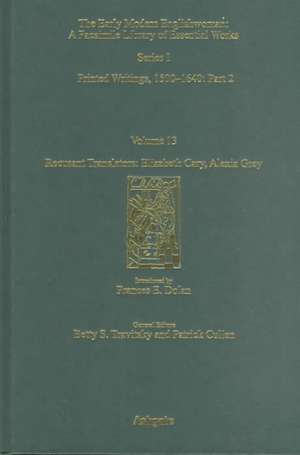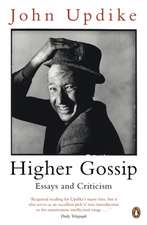Recusant translators: Elizabeth Cary and Alexia Grey: Printed Writings 1500–1640: Series I, Part Two, Volume 13: The Early Modern Englishwoman: A Facsimile Library of Essential Works & Printed Writings, 1500-1640: Series I, Part Two
Autor Frances E. Dolanen Limba Engleză Hardback – 21 iul 2000
Preț: 512.87 lei
Preț vechi: 674.95 lei
-24% Nou
Puncte Express: 769
Preț estimativ în valută:
98.22€ • 101.20$ • 82.28£
98.22€ • 101.20$ • 82.28£
Carte tipărită la comandă
Livrare economică 24 februarie-10 martie
Preluare comenzi: 021 569.72.76
Specificații
ISBN-13: 9781840142266
ISBN-10: 184014226X
Pagini: 784
Dimensiuni: 156 x 234 mm
Greutate: 1.34 kg
Ediția:1
Editura: Taylor & Francis
Colecția Routledge
Seria The Early Modern Englishwoman: A Facsimile Library of Essential Works & Printed Writings, 1500-1640: Series I, Part Two
Locul publicării:Oxford, United Kingdom
ISBN-10: 184014226X
Pagini: 784
Dimensiuni: 156 x 234 mm
Greutate: 1.34 kg
Ediția:1
Editura: Taylor & Francis
Colecția Routledge
Seria The Early Modern Englishwoman: A Facsimile Library of Essential Works & Printed Writings, 1500-1640: Series I, Part Two
Locul publicării:Oxford, United Kingdom
Cuprins
Contents: Introductory note; Elizabeth Cary, trans.: The Reply of the most illustrious Cardinall of Perron; An image of Du Perron and two holograph poems by Cary tipped into the copy of Reply at the Beinecke Rare Book and Manuscript Library, Yale University; Alexia Grey, trans.: The Rule of the Most Blissed Father Saint Benedict; Statutes. Compyled For the Better Observation of the Holy Rule of the Most Glorious Father and Patriarch S. Benedict.
Descriere
At a time when England was an officially Protestant country to translate Catholic works, thereby helping to propagate the faith, was a brave act and to actually identify oneself in print, as did Cary, as ’a Catholique, and a woman’ was a risky assertion of political opposition. One of Cary’s daughters asserts that Cary’s translation of Cardinal Du Perron’s Reply was largely motivated by a desire to convert scholars at Oxford and Cambridge. With her translation in 1630 she sought to reactivate a polemical war which had peaked in 1616 and she intervened in political debate that was far from resolved, and that would issue in revolution, regicide and restoration in the years to come. Although few copies escaped the burning ordered by Archbishop Abbot, at least ten survive. The copy reproduced here is from Cambridge University. Alexia Grey (baptised Margaret) joined the monastery of the Immaculate Conception in Ghent in 1629 at the age of twenty two or three. Hers was not the first translation of Benedict’s Rule but by that time a ’reformation’ and more than a century had rendered earlier translations unavailable. Her work was an important contribution to sustaining conventual life for Englishwomen abroad. Grey’s translation is sometimes bound, as in this volume, with Statutes compyled for the better observation of the holy rule of S. Benedict. The fine copy reproduced here is from the Downside Abbey in Bath.






![The Poets, Isabella Whitney, Anne Dowriche, Elizabeth Melville [Colville], Aemilia Lanyer, Rachel Speght, Diane Primrose and Anne, Mary and Penelope Grey: Printed Writings 1500–1640: Series I, Part Two, Volume 10](https://i3.books-express.ro/bs/9781840142235/the-poets-isabella-whitney-anne-dowriche-elizabeth-melville-colville-aemilia-lanyer-rachel-speght-diane-primrose-and-anne-mary-and-penelope-grey.jpg)















